AP Biology - Evolution Exam
1/99
There's no tags or description
Looks like no tags are added yet.
Name | Mastery | Learn | Test | Matching | Spaced |
|---|
No study sessions yet.
100 Terms
(INTRO TO EVOLUTION) Theories of Evolution: Lamarck’s Theory of Evolution (French Biology, 1744 - 1829)
Jean-Baptiste Lamarck, a French scientist proposed that species changed as a result of the habitual “use or disuse” of a feature.
Excessive use would cause a feature to develop, while continued disuse would cause it to atrophy (a condition in which a tissue or organ shrinks and wastes away when not used).
He then proposed that these modified features could be passed on to successive generations, changing the species over time.
This was referred to as “Inheritance of ACQUIRED characteristics.”
offspring will have these traits
(Ex> kids have lots of muscles if parents are active)
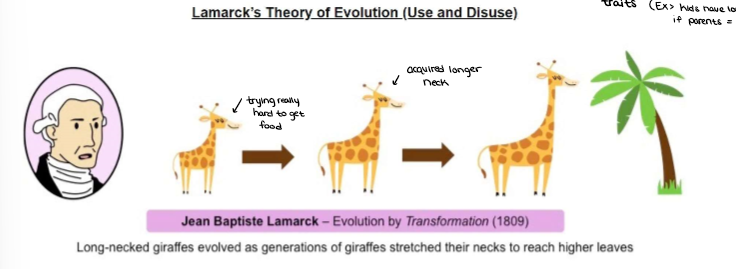
(INTRO TO EVOLUTION) Theories of Evolution: Lamarck’s Theory of Evolution (French Biology, 1744 - 1829) - What is USE OR DISUSE?
organisms use certain parts more than others that get bigger while the parts that aren’t used for a long time will waste away
(INTRO TO EVOLUTION) Theories of Evolution: Lamarck’s Theory of Evolution (French Biology, 1744 - 1829) - Was his theory APPROVED or DISPROVED by August Weismann?
Lamarck’s theory was disproved by August Weismann (1870’s) with his experiments: He cut off the tails of mice for 19 generations (producing 904 offspring) to see if this “acquired characteristic” was passed on. Each subsequent generation has a tail (innate/within them b/c of DNA.
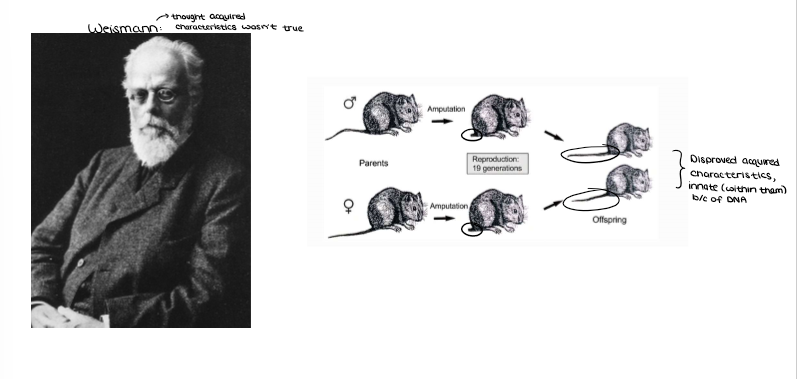
(INTRO TO EVOLUTION) Darwin’s Theory of Evolution: Charles Darwin, a British geologist, naturalist, and biology (1809 - 1882)
Darwin’s theory of evolution was based on a combination of Lamarckian ideas and recent fossil discoveries.
He theorized that species living today have been changed over time and stemmed from a single ancestral organism → “Descent with Modification” (DNA molecule is the same in humans, bacteria, etc., so this is proof we evolved from a common ancestor)
The mechanism of this change over time he described as “Natural Selection,” which is outlined below.
Most significant observations were made at the Galapagos Islands (off the coast of Ecuador) where he noted several species of finches living on each of the islands. Each find had a special adaptation that best suited the conditions and resources on that particular island.
Similar ideas were proposed at the same time by Alfred Wallace (1823 - 1913), a British naturalist (he corresponded with Darwin but published separately).
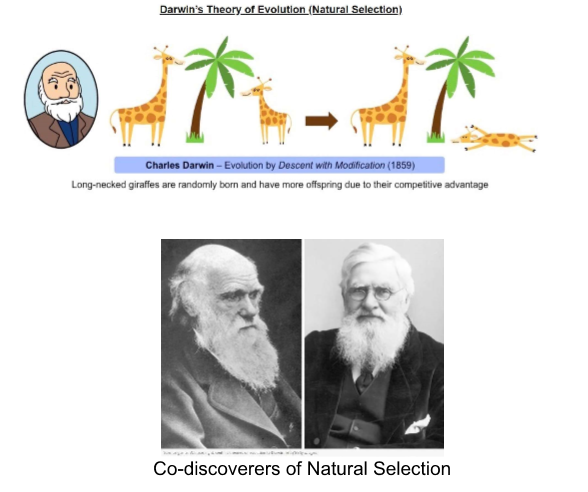
(INTRO TO EVOLUTION) Darwin’s Theory of Evolution: In one of the most important and controversial books ever written, On the Origin of Species by Means of Natural Selection, published in 1859. Charles Darwin had 2 main points…
Species living today descended from an ancestral species. (“DESCENT WITH MODIFICATION”)
Evolution occurs through NATURAL SELECTION.
(INTRO TO EVOLUTION) A deeper dive into Evolution by Natural Selection, biology’s core theme: It examples both the _____ and _________ amongst living things.
unity
diversity
(INTRO TO EVOLUTION) The process of natural selection has several components…
OVERPOPULATION → Most populations have more offspring each year than local resources can support (pandemics reduce population in the case of overpopulation). Additionally, within this large population, there is much VARIATION → Organisms within populations exhibit individual variation in appearance and behavior. These variations may involve any physical/visible trait (like hair color, eye color) and also physiological traits (like functions of organs). Sometimes variations are favorable & sometimes they are not favorable for survival.
COMPETITION → a struggle for resources (including food, mates, shelter. Those individuals with beneficial/favorable variations experience…
You live longer and reproduce more. Fitness refers to being fit when you put ore genes in gene pool. Others will not do as well (ex> colleges, English vs. Bio) but not die.
DIFFERENTIAL SURVIVAL AND REPRODUCTION
Individuals possessing traits well suited for the struggle for local resources will contribute more offspring to the next generation because…
These adaptive traits can be INHERITED.
Some traits (which we now know as GENES) are consistently passed on from parent to offspring. When genes are favorable, they will tend to increase in the population over time; whereas less favorable traits may decrease in the population. This can lead to changes in “GENE POOL” → the stock of different genes in an interbreeding population.
GENE POOL: genes within population, add to gene pool w/ favorable genes
(INTRO TO EVOLUTION) These components of NATURAL SELECTION cause… What is SPECIATION?
… populations to EVOLVE into a better adapted species over time (microevolution) or…
This may even lead to SPECIATION → the development of entire new species if there are enough changes over time (macroevolution)
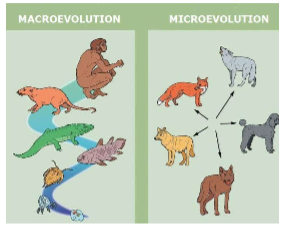
(INTRO TO EVOLUTION) What is MICROEVOLUTION?
refers to small-scale changes that affect just one or a few genes and happen in populations over shorter timescales.
→ same species w/ little changes
Microevolution leads to macroevolution…
(INTRO TO EVOLUTION) What is MACROEVOLUTION?
refers to large-scale changes that occur over extended time periods, such as the formation of new species and groups
→ speciation, ancestors are so diff that they are classified separately
(INTRO TO EVOLUTION) What is SURVIVAL OF THE FITTEST?
Individuals who have better suited traits (adaptations) for their environment will survive longer, have more offspring, and pass these favorable genes on to the next generation
(INTRO TO EVOLUTION) Can INDIVIDUALS evolve?
Remember → INDIVIDUALS CAN NOT EVOLVE!
By taking care of everyone (those that are sick), we prevent humans from evolving

(INTRO TO EVOLUTION) We now understand Darwin’s theory and can see evidence of such changes in the “gene pool” for a species over time. Examples include resistance to antibiotics and herbicides. Use Darwin’s theory of Natural Selection to explain the example below.
Variation in the DNA causes one/few bacteria to be naturally resistant (innate) to certain drugs.
These "naturally selected" bacteria (by chance) can then survive against the drug treatment.
Through asexual reproduction, the drug resistant gene increases in the population… leading to the evolution of a drug-resistant strain of bacteria!
(INTRO TO EVOLUTION) What is GENETIC DRIFT?
Ex> Genetic Drift (population is wiped out by an event): frogs are on a bus and get into an accident; the green frogs are the highest in the gene pool, but after, there is not a single green survivor (only blue and red left), so the gene pool is going to be changed tremendously (whatever alleles are left is what will repopulate) --> Bottleneck
(INTRO TO EVOLUTION) Variations within populations are caused by…
SEXUAL REPRODUCTION → new combinations of genes!
Formation of gametes: crossing over, Independent Assortment during meiosis
Random fertilization between egg and sperm (most cancers are not inherited because they are not coded in the egg + sperm and can’t be passed down)
MUTATION → chance/random changes in the sequence of DNA
(INTRO TO EVOLUTION) What causes changes in the gene/allele pool over time? (CAUSES OF (Micro) EVOLUTION IN POPULATIONS)
(middle finger) MUTATION → random changes in the DNA (must be in the gametes)
(pointer finger) GENE FLOW → immigration brings new genes in, and emigration removes genes
(pinky) GENETIC DRIFT → population size is drastically reduced due to a random event (Ex. frogs on bus → shrinking)
(ring finger) SELECTIVE REPRODUCTION (non-random mating) → new combination of genes, favorable genes are selected which leads to…
(thumb) NATURAL SELECTION!
only one that leads to adaptation
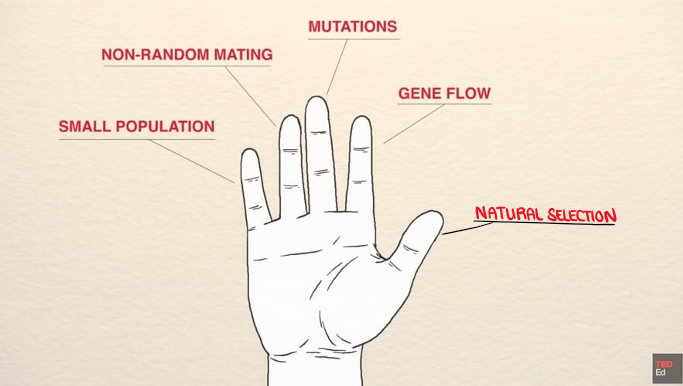
(INTRO TO EVOLUTION) EVIDENCE OF EVOLUTION
Fossils
Homologous Structures (vs. Analogous Structures)
Embryological Evidence
Biochemical Evidence
Observe examples of Natural Selection
(INTRO TO EVOLUTION) 1. The Fossil Record - What are FOSSILS?
Fossils are the preserved remains of previously living organisms or their traces, dating from the distant past. The fossil record is not complete or unbroken:" most organisms never fossilize are rarely found by humans. Nonetheless, the fossils that humans have collected offer unique insights into evolution over long timescales.
(INTRO TO EVOLUTION) 1. The Fossil Record - What do the fossils show?
Remains of animals and plants found in sedimentary rock deposits give us a record of changes through time.
Some extinct species had traits that were transitional between major groups of organisms. The existence of transitional forms confirms that species are not fixed but can evolve into other species over time.
Fossils document the existence of now-extinct species, showing that different organisms have lived on Earth during different periods of the planet’s history. They can also help scientists reconstruct the evolutionary histories of present-day species. For instance, some of the best-studied fossils are of the horse lineage. Using these fossils, scientists have been able to reconstruct a large, branching “family tree” for horses and their now-extinct relatives. Changes in the lineage leading to modern-day horses, such as the reduction of toed feet to hooves, may reflect adaptation to changes in the environment.
The fossil record, though incomplete, provides information about what species existed at particular times of Earth’s history.
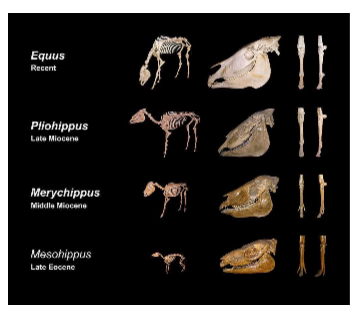
(INTRO TO EVOLUTION) 1. The Fossil Record - What is STRATA?
Earth’s rocks form layers on top of each other over very long time periods. These layers, called strata, form a convenient timeline for dating embedded fossils. Strata that are closer to the surface represent more recent time periods, whereas deeper strata represent older time periods.
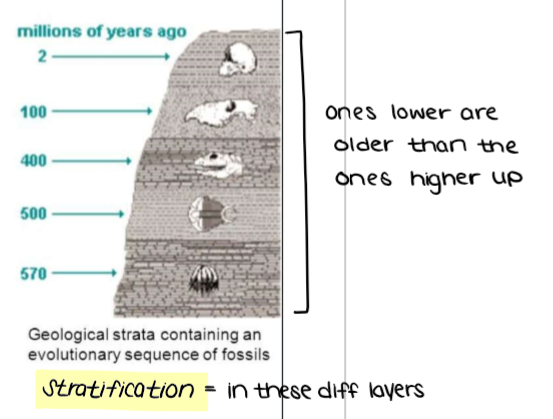
(INTRO TO EVOLUTION) 1. The Fossil Record - What is RADIOCARBON DATING?
In addition, scientists can roughly date fossils using radiocarbon dating, a process that measures the radioactive decay of certain elements.
(INTRO TO EVOLUTION) 1. The Fossil Record - What are the LIMITATIONS of FOSSILS?
Limited info due to…
fossils erode over time
some don’t have bones
missing fossils due to disruption on Earth
only showing relative age
(INTRO TO EVOLUTION) 2. Homologous Structures as Evidence of Evolution - What are HOMOLOGOUS STRUCTURES?
If two or more species share a unique physical feature, such as complex bone structure or a body plan, they may all have inherited this feature from a common ancestor.
Homologous structures are physical features shared by different species due to evolutionary history (a common ancestor).
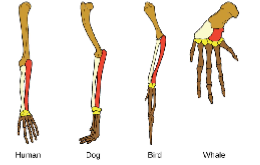
(INTRO TO EVOLUTION) 2. Homologous Structures as Evidence of Evolution - Give an example of HOMOLOGOUS STRUCTURES.
To give one classic example, the forelimbs of whales, humans, birds, and dogs look different on the outside. That’s because they’re adapted to function in different environments. However, if you look at the bone structure of the forelimbs, you’ll find that the pattern of bones is very similar across species. It’s unlikely that such similar structures would have evolved independently in each species, and more likely that the basic layout of bones was already present in common ancestor of whales, humans, dogs, and birds.
(INTRO TO EVOLUTION) 2. Homologous Structures as Evidence of Evolution - Structural homologies indicate a ______ _______ ________.
shared common ancestor

(INTRO TO EVOLUTION) 2. Homologous Structures as Evidence of Evolution - Homologous structures amongst different species are evidence of ________ ________ (________ _________).
DIVERGENT EVOLUTION (ADAPTIVE RADIATION) → ancestral species gives rise to many different species, each evolving adaptations for different environments (so they have similar structures but different functions)
(INTRO TO EVOLUTION) 2. Homologous Structures as Evidence of Evolution - What is a VESTIGAL STRUCTURE?
A “vestigial structure” or “vestigial organ” is an anatomical feature or behavior that no longer seems to have a purpose in the current form of an organism of the given species. Often, these vestigial structures were organs that performed some important functions in the organism at one point in the past.
(INTRO TO EVOLUTION) 2. Homologous Structures as Evidence of Evolution - Give some examples of VESTIGAL STRUCTURES.
Examples of vestigial structures include the tailbone of humans (a vestigial tail), the hind leg bones of whales, and the underdeveloped legs found in some snakes.
APPENDIX: common ancestors would consume raw meat, broke down the raw materials, we can’t eat raw meat today b/c we don’t have the enzymes to break down the pathogens
GOOSEBUMPS: we used to have hair all over, going outside hair would rise up (cold) → like a cat
WISDOM TEETH: needed extra teeth for pulling
TAIL BONE: common ancestors had tail
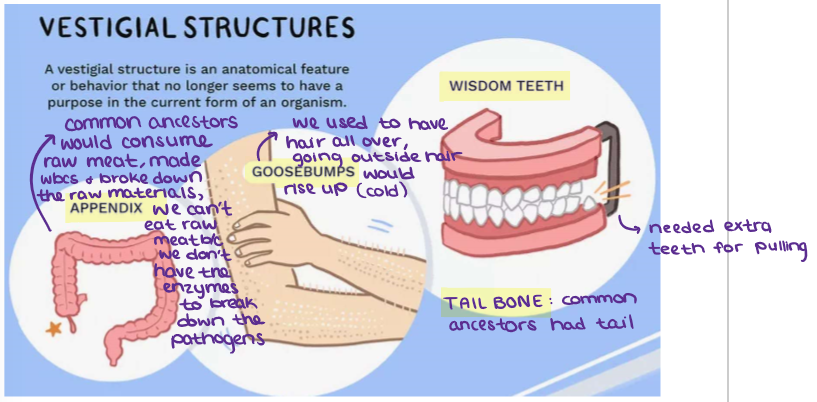
(INTRO TO EVOLUTION) 2. Homologous Structures as Evidence of Evolution - What are ANALOGOUS STRUCTURES?
These structures are NOT due to closely related ancestry.
They have similar FUNCTION but are different structures.
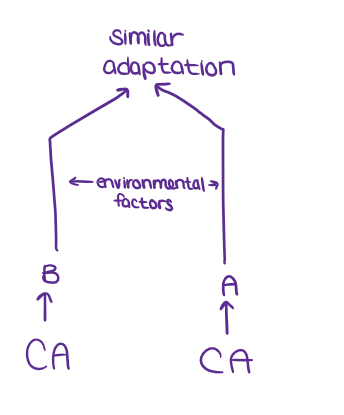
(INTRO TO EVOLUTION) 2. Homologous Structures as Evidence of Evolution - What are ANALOGOUS STRUCTURES EVIDENCE of?
Analogous structures are evidence of CONVERGENT EVOLUTION; when unrelated species develop similar adaptations because they live in similar environments or experience similar selective pressures.
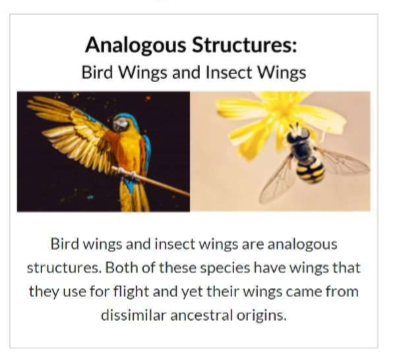
(INTRO TO EVOLUTION) 2. Homologous Structures as Evidence of Evolution - Compare ANALOGOUS STRUCTURES and HOMOLOGOUS STRUCTURES.
ANALOGOUS STRUCTUES
Dissimilar in anatomy
Similar Functions
Develop in unrelated animals
Not inherited from a common ancestor
HOMOLOGOUS STRUCTURES
Similar in anatomy
Dissimilar functions
Develop in related animals
Inherited from a common ancestor
(INTRO TO EVOLUTION) 3. Embryological Evidence of Evolution
Some homologous structures can be seen only in embryos.
For instance, all vertebrate embryos (including humans) have gill slits and a tail during early development! The developmental patterns of these species become more different later on (which is why your embryonic tail is now your tailbone, and your gill slits have turned into your jaw and inner ear). Homologous embryonic structures reflect that the developmental programs of vertebrates are variations on a similar plan that existed in their last common ancestor.
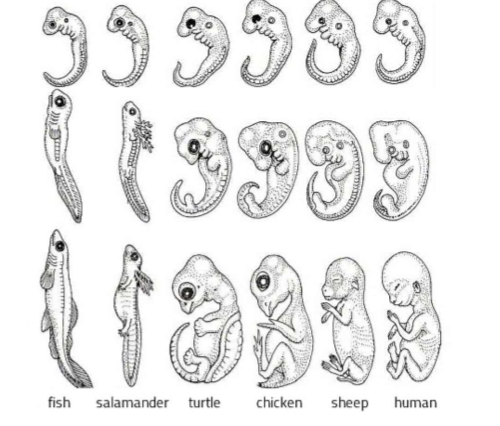
(INTRO TO EVOLUTION) 3. Embryological Evidence of Evolution - The longer the embryos resemble each other…
…the more closely related the species.
(INTRO TO EVOLUTION) 4. Molecular/Biochemical Evidence of Evolution - At the most basic level, all living organisms share…
Like structural homologies, similarities between biological molecules can reflect shared evolutionary ancestry.
same genetic material (DNA)
same (or highly similar) genetic codes
same basic process of gene expression (transcription + translation)
same molecular building blocks, such as amino acids
(INTRO TO EVOLUTION) 4. Molecular/Biochemical Evidence of Evolution - What do these SHARED FEATURES suggest?
These shared features suggest that all living things are descended from a common ancestor, and that this ancestor had DNA as its genetic material, used the genetic code, and expressed its genes by transcription and translation. Present-day organisms all share these features because they were “inherited” from their ancestors.
(INTRO TO EVOLUTION) 4. Molecular/Biochemical Evidence of Evolution - Why are features like having DNA or carrying out transcription and translation not so useful for figuring out how related particular organisms are?
If we want to determine which organisms in a group are most closely related, we need to use different types of molecular features such as the nucleotide sequences of genes, or the sequence of amino acids in proteins. The more DNA two species have in common, the more closely related they are.
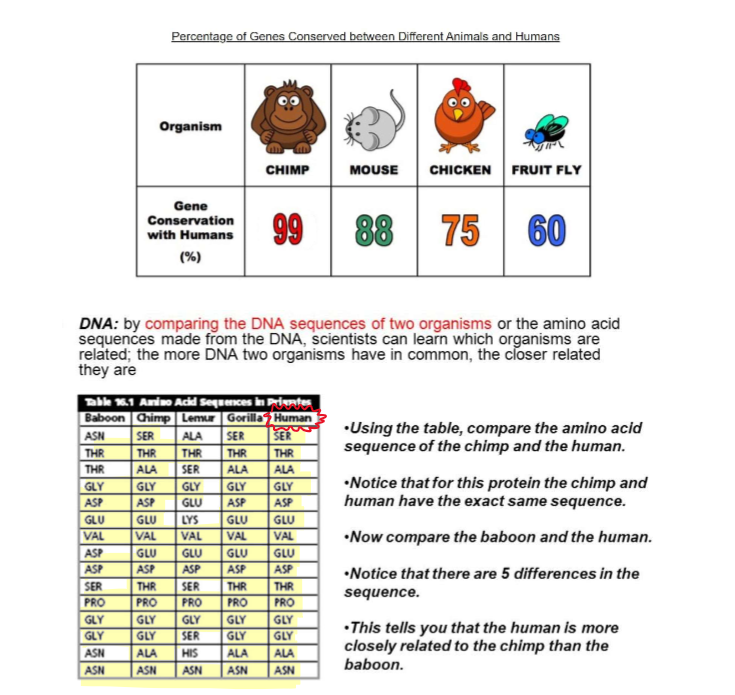
(INTRO TO EVOLUTION) 4. Molecular/Biochemical Evidence of Evolution - What are the HIGHLY CONSERVED SEQUENCES of DNA that remain in most organisms?
genes for cell membrane
genes for ribosomes
genes for proteins (involved in: transcription + translation)
*Cellular Respiration
CYTOCHROME C - highly conserved protein
(INTRO TO EVOLUTION) Patterns of Evolution: What is ADAPTIVE RADIATION (DIVERGENT EVOLUTION)?
Have a common ancestor, and similar structures that have evolved to perform different functions (homologous)
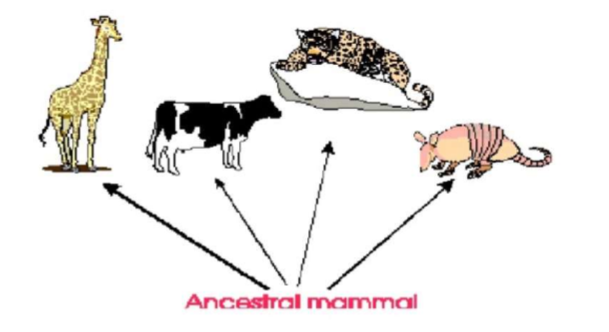
(INTRO TO EVOLUTION) Patterns of Evolution: What is CONVERGENT EVOLUTION?
No common ancestor (very diff ancestry), but similar structures evolved due to similar environmental selective pressure (analogous structures form)
Example: Sharks (evolved from ancient fish) and dolphins (evolved from land-dwelling mammals) both have streamlined bodies, fins, and tails that help them move quickly through water.
Even though they come from very different ancestors, both developed similar body shapes and adaptations because they live in the same type of environment (the ocean) and face similar selective pressures for fast swimming and efficient hunting.
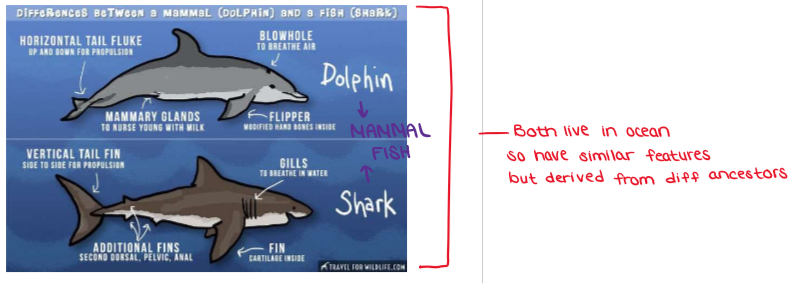
(INTRO TO EVOLUTION) Patterns of Evolution: What is CO-EVOLUTION?
(2 species have to evolve together) Evolution occurs in response to a change in the environment. In fact, species in symbiotic relationships tend to evolve together. This is called coevolution. As one species changes, the other species must also change in order to adapt.
Examples: Pollinators/Flowers, Predator/Prey (if the prey is evolving to camouflage better → the predator needs to evolve to be able to spot)

(INTRO TO EVOLUTION) Patterns of Evolution: What is PARALLEL EVOLUTION?
Parallel evolution is when two or more closely related species independently evolve similar traits in response to similar environmental pressures. This process highlights how similar selective forces can lead to comparable evolutionary outcomes in different lineages that share a common ancestor (more closely related but environments still influence).
Examples:
Old World and New World monkeys both developed similar body forms, opposable thumbs, and social behaviors — even though they evolved on different continents (Africa/Asia vs. South America) and evolved separately for millions of years.
Marsupial and placental mammals (like the marsupial sugar glider in Australia and the placental flying squirrel in North America) both evolved flaps of skin for gliding, even though they belong to different mammalian lineages.
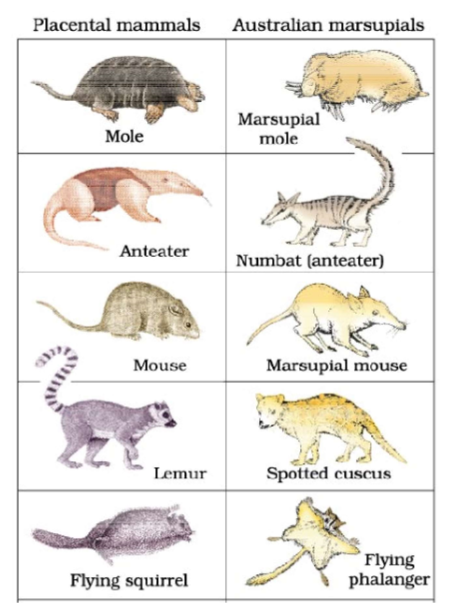

(INTRO TO EVOLUTION) Patterns of Evolution: Above each picture, indicate if it represents: parallel, co-evolution, convergent, or divergent evolution

(INTRO TO EVOLUTION) Patterns of Evolution: What can the PATTERNS OF EVOLUTION lead to?
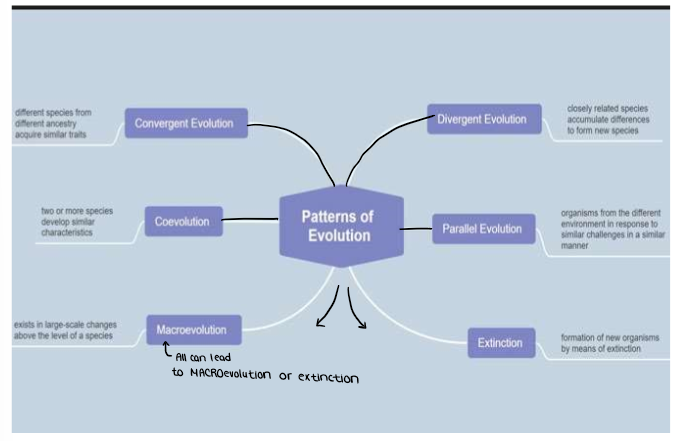
(PHYLOGENETICS) TAXONOMY & PHYLOGENY: What is TAXONOMY?
Taxonomy in biology encompasses the ___________, _____________, ____________, and _____________ of organisms — this classification system was developed by the Swedish scientist Carl ________ (1707 - 1778), providing a ____________ way to categorize and communicate information about the vast diversity of life on Earth.
Taxonomy is the _______ __ ___________ ___ ______ ______ _________ based on shared characteristics and evolutionary relationships.
It involves __________ _______ ____ ____________ __________, such as kingdom, phylum, class, order, family, genus, and species.
Taxonomy helps scientists understand the ___________ _______ and _____________ among organisms, facilitating the study of ____________, _______, and ________.
description
identification
nomenclature
classification
Linnaeus
standardized
science of classifying and naming living organisms
organizing species into hierarchical categories
evolutionary history
relationships
biodiversity
ecology
evolution
(PHYLOGENETICS) TAXONOMY & PHYLOGENY: What are the HIERARCHICAL CATEGORIES?
Domain
Kingdom
Phylum
Class
Order
Family
Genus
Species
(dumb king phillip came over from germany sea)
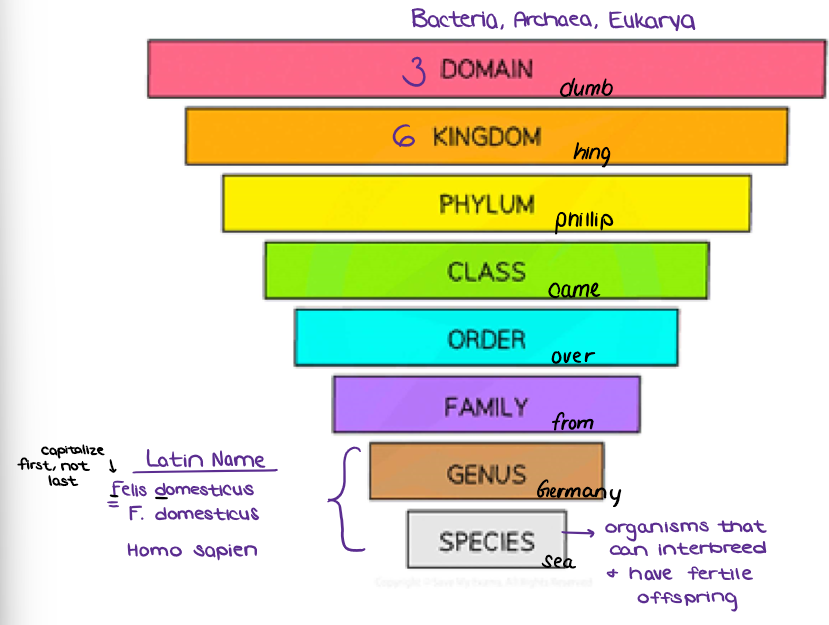
(PHYLOGENETICS) TAXONOMY & PHYLOGENY: Each group above is called a _____ (plural: ____).
TAXON
TAXA
(PHYLOGENETICS) TAXONOMY & PHYLOGENY: What are SPECIES?
organisms that can interbreed and have fertile offspring
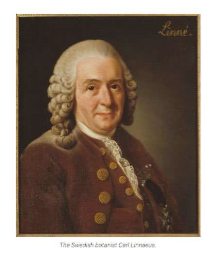
(PHYLOGENETICS) TAXONOMY & PHYLOGENY: What is LINNAEUS credited with developing?
Carl Linnaeus is credited with developing the system of binomial nomenclature.
(PHYLOGENETICS) TAXONOMY & PHYLOGENY: What is BINOMIAL NOMENCLATURE?
a method of naming living organisms using two Latin words: the first representing the genus and the second representing the species
Ex> Latin Name: Felis domesticus (F. domesticus), Homo sapien
(PHYLOGENETICS) TAXONOMY & PHYLOGENY: To write a species name…
The entire name must be in italics (or underlined)
The genus name is always written first.
The first letter of the genus MUST be capitalized.
The species name is NEVER capitalized.
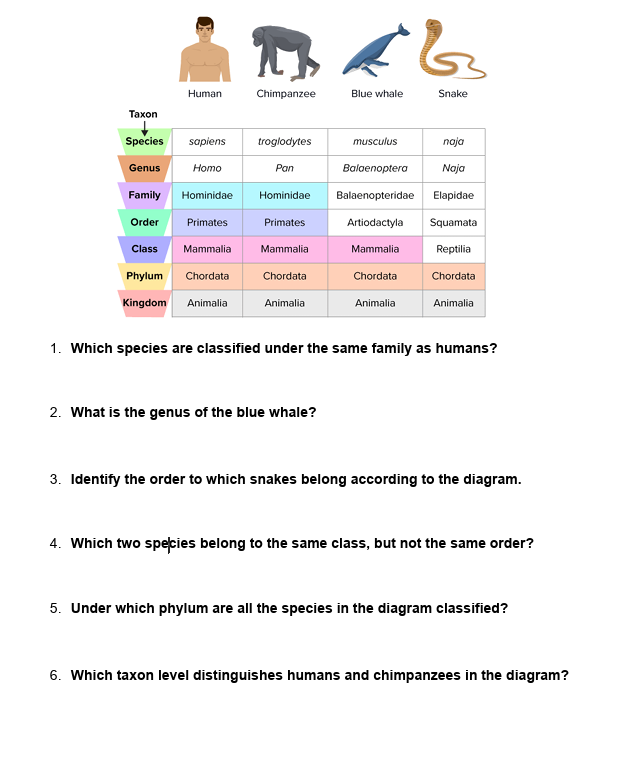
(PHYLOGENETICS) TAXONOMY & PHYLOGENY: Fill out the worksheet on TAXONOMY.
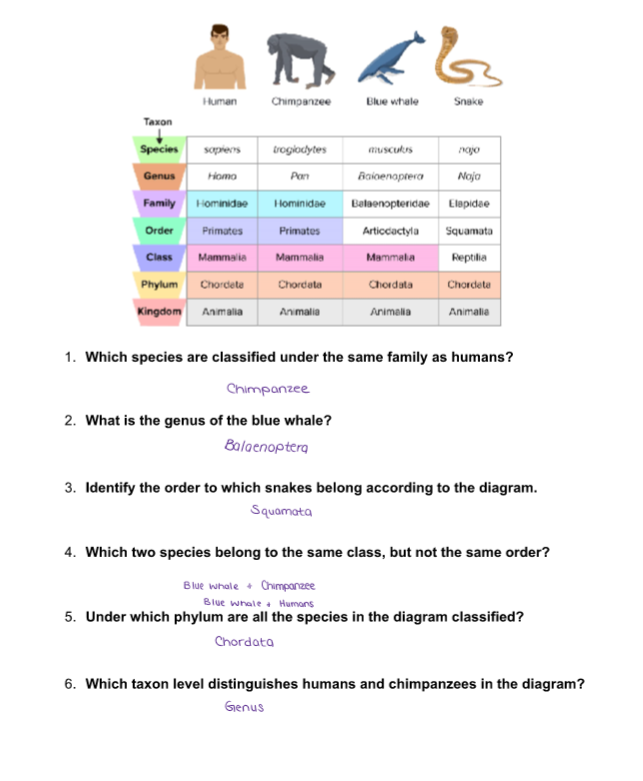
(PHYLOGENETICS) Over the last 3.7 billion years or so, living organisms on the Earth have diversified and adapted to almost every environment imaginable. Biologists estimate that there are up to 100 million species of organisms living on Earth today. What is PHYLOGENETICS?
Phylogenetics is the study of the evolutionary relationships between organisms, species, or genes. It involves reconstructing the evolutionary history of organisms using present-day data, such as amino acid, DNA and RNA sequencing.
(PHYLOGENETICS) What is the GOAL of PHYLOGENETICS?
The goal of phylogenetics is to create a visual representation of the ____________ _____________ between organisms, known as a ____________ ____. This tree shows how organisms are related to each other through their ______ ________.
evolutionary relationships
phylogenetic tree
shared ancestry
(PHYLOGENETICS) What is a PHYLOGENETIC TREE?
A phylogenetic tree, also known as a cladogram, or an evolutionary tree, is a diagram that shows the evolutionary relationships between biological species or other entities. It’s a branching diagram that uses nodes and branches to represent taxonomic units and behaviors, biochemical pathways, anatomy, and morphology. They show: probable relationships, probable sequence of origin, & shared derived characters.
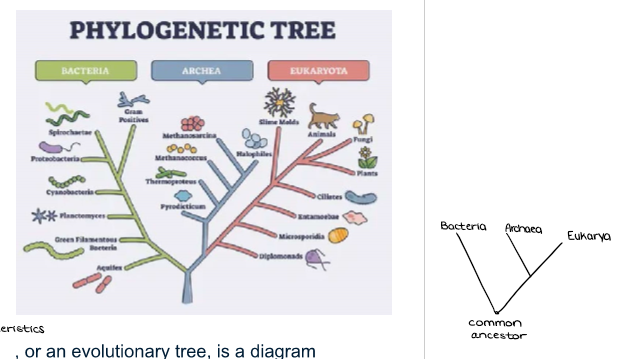
(PHYLOGENETICS) What is a BASAL TAXON?
A basal taxon, or the outgroup is a lineage that does not branch again after it branches from the root/ancestor common to the entire tree.
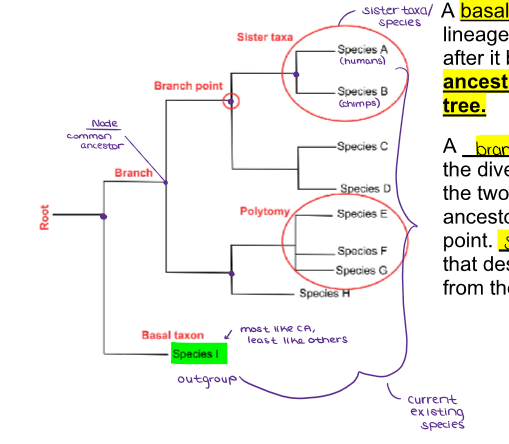
(PHYLOGENETICS) What is a BRANCH POINT/NODE?
A branch point/node represents the divergence of two species, and the two species’ most recent common ancestor is represented by the branch point.
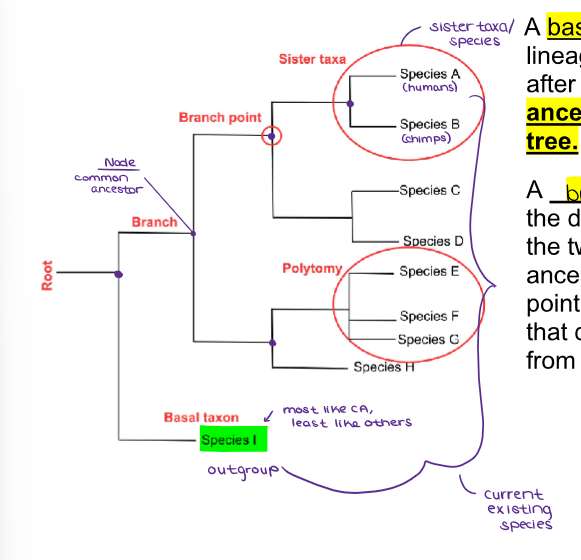
(PHYLOGENETICS) What are SISTER TAXA?
Sister taxa is the term that describes two lineages that come from the node.

(PHYLOGENETICS) What is a PRIMITIVE CHARACTER?
1st derived character in the cladogram
(PHYLOGENETICS) What is a DERIVED CHARACTER?
new traits that are formed & shared by all members of a clade

(PHYLOGENETICS) Label the diagram.

(PHYLOGENETICS) A cladogram is a diagram that visually represents the evolutionary relationships between different organisms, showing how they are connected through ______ _______ ____________ and ______ _________, often depicted as a branching tree structure where each branch represents a distinct group of organisms called a _____.
shared derived characteristics
common ancestors
clade
(PHYLOGENETICS) What is a CLADE?
a distinct group of organisms represented by each branch
(PHYLOGENETICS) Shared Primitive Character v. Derived Character: A “shared primitive character” refers to a trait that is present in ________ ________ because it was inherited from a ______ common ancestor, while a “derived character” is a trait that evolved more recently within a ________ _______, distinguishing that group from other related organisms; essentially a shared primitive character is an ___ ______ _______ __ _____, while a derived character is a _____ _____ ________ __ _ _______ _____. Derived traits are those that just appeared (by mutation) in the most _____ ________ — the one that gave rise to a _____ ______ ______.
multiple organisms
distant
specific lineage
old trait shared by many
newer trait specific to a smaller group
recent ancestor
newly formed branch

(PHYLOGENETICS) Fill out the cladogram worksheet.
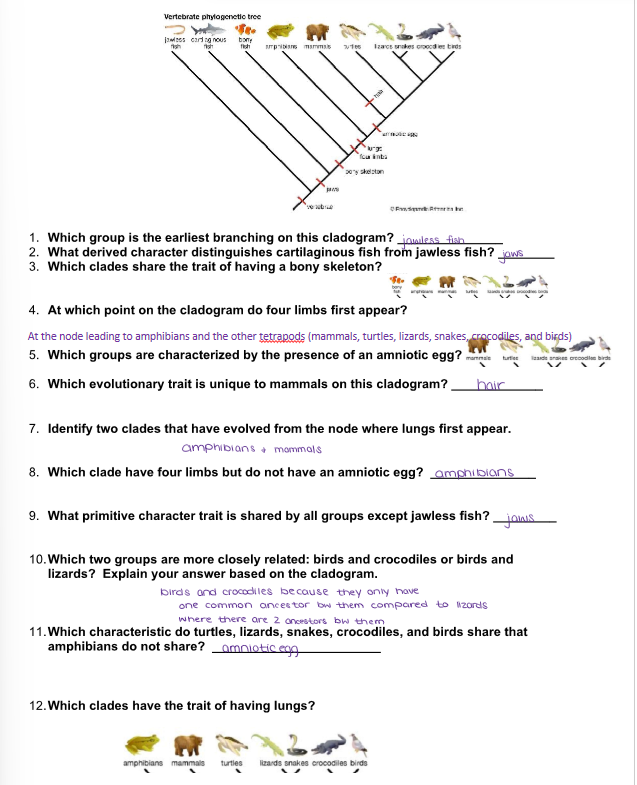
(The Origin of Life & the First Cells) What is the OPARIN-HALDANE HYPOTHESIS (1920s)?
A scientific model proposing that life began when simple molecules in Earth’s early atmosphere reacted (with the help of lightning, volcanic activity, and UV radiation) to form organic molecules necessary for life.
Early Earth had a reducing atmosphere (an environment that lacks oxidizing gases, and instead contains gases that readily remove oxygen from other substances).
This environment allowed organic molecules to form spontaneously.
Organic molecules accumulated in the oceans → known as the “primordial soup.”
(The Origin of Life & the First Cells) Why does the Oparin-Haldane Hypothesis matter for EVOLUTION?
Creating organic molecules is step 1 in forming the building blocks (amino acids, nucleotides) that can eventually lead to gene-containing protocells.
(The Origin of Life & the First Cells) What is the MILLER-UREY EXPERIMENT?
What They Did:
Simulated early Earth atmosphere inside a closed system.
Added water (oceans), CH₄, NH₃, H₂ (atmosphere), and electrical sparks (lightning).
What They Found:
Within days, the system produced amino acids, simple sugars, lipids, and other organic molecules.
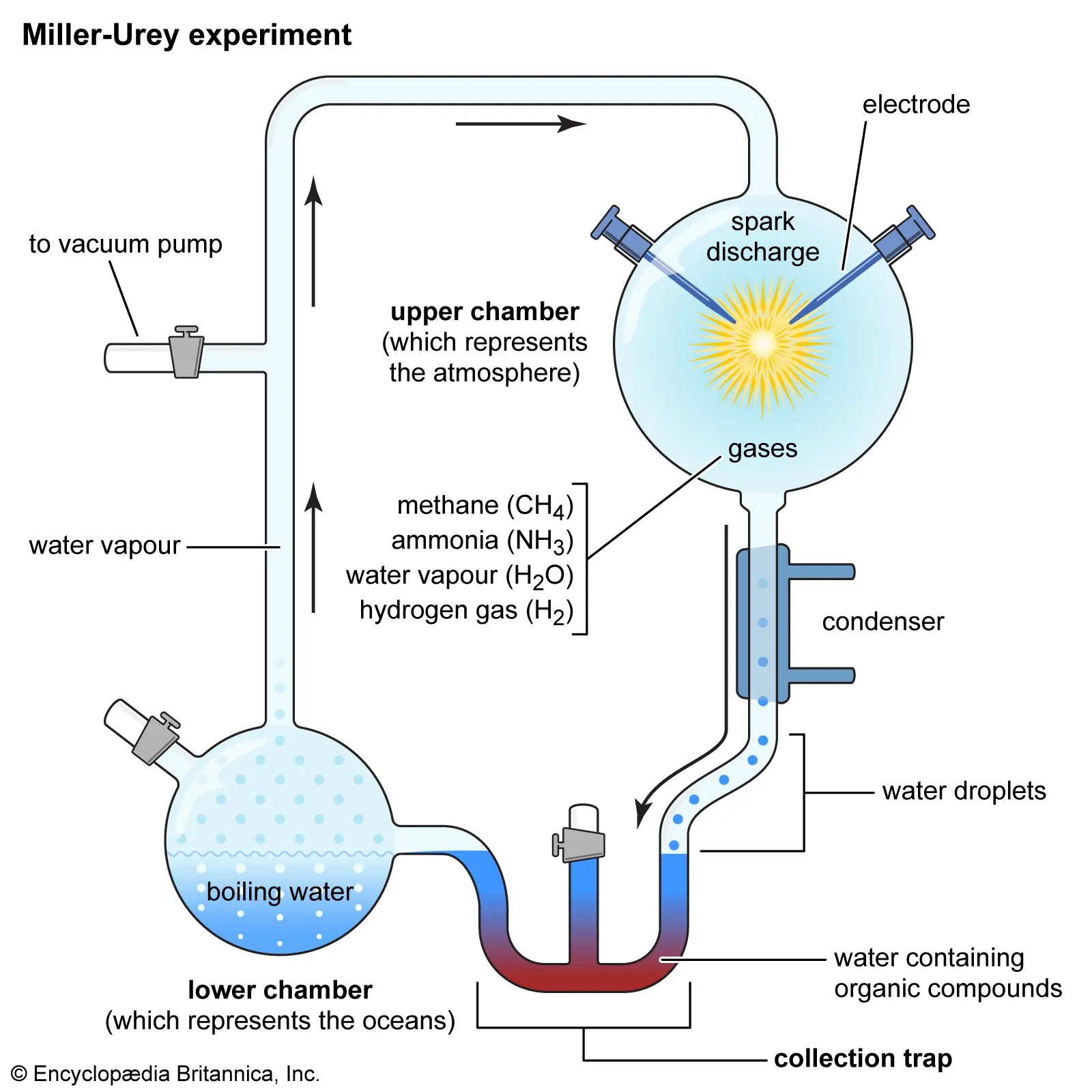
(The Origin of Life & the First Cells) Why does the Miller-Urey Experiment matter for EVOLUTION?
This experiment provided experimental evidence that abiotic synthesis of organic molecules is possible—supporting the Oparin–Haldane hypothesis.
(The Origin of Life & the First Cells) From Primitive Earth to Eukaryotes: I. Conditions on Primitive Earth (~4.6-3.8 billion years ago)
Atmosphere was very different from today
Contained water vapor (H2O), methane (CH4), ammonia (NH3), hydrogen gas (H2), and nitrogen (N2)
Intense energy sources
Lightning, volcanic activity, UV radiation from the sun
Oceans formed as Earth cooled → “Primordial Soup”
(The Origin of Life & the First Cells) From Primitive Earth to Eukaryotes: II. Formation of Simple Organic Molecules
High-energy environment allowed inorganic molecules → organic molecules
Amino acids, nucleotides, simple sugars
These molecules accumulated in the oceans (the “soup”)
(The Origin of Life & the First Cells) From Primitive Earth to Eukaryotes: III. Formation of Complex Organic Molecules
Organic molecules began to link together
Polypeptides (proteins)
Polysaccharides (carbohydrates)
Nucleic acids
Increasing complexity set the stage for early “cell-like” structures
(The Origin of Life & the First Cells) From Primitive Earth to Eukaryotes: IV. Formation of Coacervates (Primitive Cell-Like Droplets)
Organic molecules clustered together in water
These coacervates had:
A boundary separating them from the environment
Ability to maintain internal chemistry
Coacervates = proto-cells (not alive yet but showing cell-like organization)
(The Origin of Life & the First Cells) From Primitive Earth to Eukaryotes: V. RNA World → First Self-Replicating Molecules
RNA likely came before DNA
Can store information
Can act as an enzyme (ribozyme)
Coacervates that trapped RNA gained ability to replicate, mutate, and evolve
These were the first true cells
(The Origin of Life & the First Cells) From Primitive Earth to Eukaryotes: VI. First Prokaryotes: Heterotrophic Anaerobes
Early cells absorbed organic molecules from the environment
These earliest organisms were:
Heterotrophs (got food from environment)
Anaerobic (no O2 available)
Natural selection favored more efficient nutrient uptake and metabolism
(The Origin of Life & the First Cells) From Primitive Earth to Eukaryotes: VII. Evolution of Autotrophs (Photosynthetic Prokaryotes)
As food became scarce, some cells evolved ways to produce their own food
Earth chemosynthesis
Later photosynthesis
Cyanobacteria developed oxygen-releasing photosynthesis
O2 accumulated in the atmosphere → “Oxygen Revolution”
(The Origin of Life & the First Cells) From Primitive Earth to Eukaryotes: VIII. Oxygen Creates New Selective Pressures
Oxygen was toxic to many anaerobic cells
Some evolved ways to tolerate and use oxygen
Development of aerobic respiration (much more efficient energy production)
(The Origin of Life & the First Cells) From Primitive Earth to Eukaryotes: IX. Evolution of Eukaryotic Cells (Endosymbiosis)
Larger anaerobic prokaryotes engulfed smaller aerobic bacteria
These bacteria survived inside → became mitochondria
Later, some cells engulfed photosynthetic bacteria
These became chloroplasts
This endosymbiotic theory explains the origin of:
Eukaryotic cells
Organelle structure
Dual membranes and separate DNA in mitochondria/chloroplasts
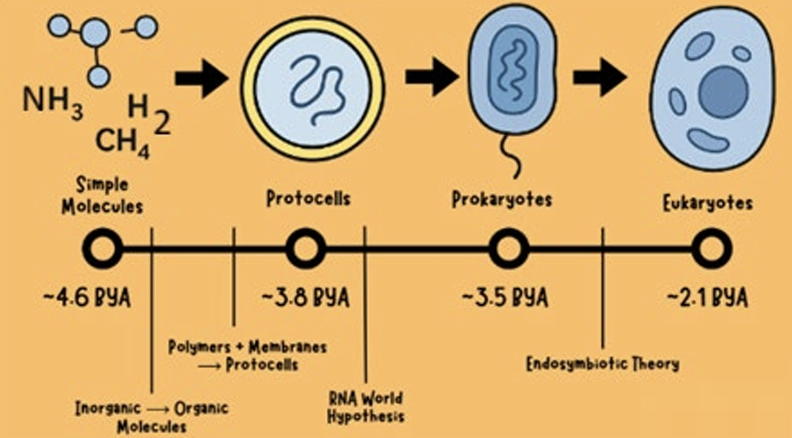
(The Origin of Life & the First Cells) How does this relate to CHANGES IN GENE FREQUENCIES?
Abiogenesis itself is not evolution, but once replicating molecules exist:
Mutations occur
Variations accumulate
Natural selection favors more stable/faster-replicating molecules
Populations of protocells change over time
→ Microevolution starts at the protocell stage.
→ Macroevolution occurs when protocells diverge into major new forms (prokaryotes → eukaryotes).
(Artificial vs. Natural Selection) What is NATURAL SELECTION?
A process in which environmental pressures determine which individuals survive and reproduce. Organisms with heritable traits that increase fitness become more common.
Selective Agent: The environment (predators, climate, food availability, competition, disease).
Outcome: Traits that improve survival/reproduction increase in frequency over generations.
Type of evolution: Primarily microevolution, but accumulated changes can lead to macroevolution (new species) over long periods.
(Artificial vs. Natural Selection) What is ARTIFICIAL SELECTION?
A process in which humans choose which individuals breed based on desired traits.
Selective Agent: Humans, with intentional choice.
Outcome: Rapid changes in traits; often exaggerated characteristics not always beneficial in nature.
Type of evolution: Strong microevolution due to intense selection by humans.
(Artificial vs. Natural Selection) What is an EXAMPLE of NATURAL SELECTION?
Darwin’s Finches
Drought favored birds with larger beaks (could crack tough seeds).
Beak depth increased in population.
(Artificial vs. Natural Selection) What is an EXAMPLE of ARTIFICIAL SELECTION?
Selective Breeding of Dogs
All domestic dog breeds descend from wolves.
Humans selected for friendliness, size, coat type, herding ability, etc.
(Artificial vs. Natural Selection) How does NATURAL SELECTION drive EVOLUTION?
Individuals with advantageous alleles leave more offspring.
Over generations, those alleles increase → microevolution.
With enough time + isolation, can cause speciation → macroevolution.
Often maintains/reshapes genetic diversity
(Artificial vs. Natural Selection) How does ARTIFICIAL SELECTION drive EVOLUTION?
Humans choose the alleles they want.
Desired alleles rise, often faster than in natural selection.
Mostly leads to microevolution but can create extreme phenotypes.
Often reduces genetic diversity
(Artificial vs. Natural Selection) ETHICAL ISSUES: Should Humans Control Evolution?
Pros
Improve food supply (disease-resistant crops).
Create animals with helpful traits (therapy dogs, livestock efficiency).
Restore endangered species through controlled breeding.
Cons
Reduced genetic diversity can cause vulnerability (Irish potato famine).
Unintentional harm (e.g., pugs with breathing problems).
Raises concerns about humans controlling the genetics of other species.
Potential misuse with biotechnology or gene editing.
(Patterns of Natural Selection) What is DIRECTIONAL SELECTION?
Directional selection occurs when one extreme phenotype has higher fitness than all other phenotypes. This pushes the population’s trait distribution toward one direction.
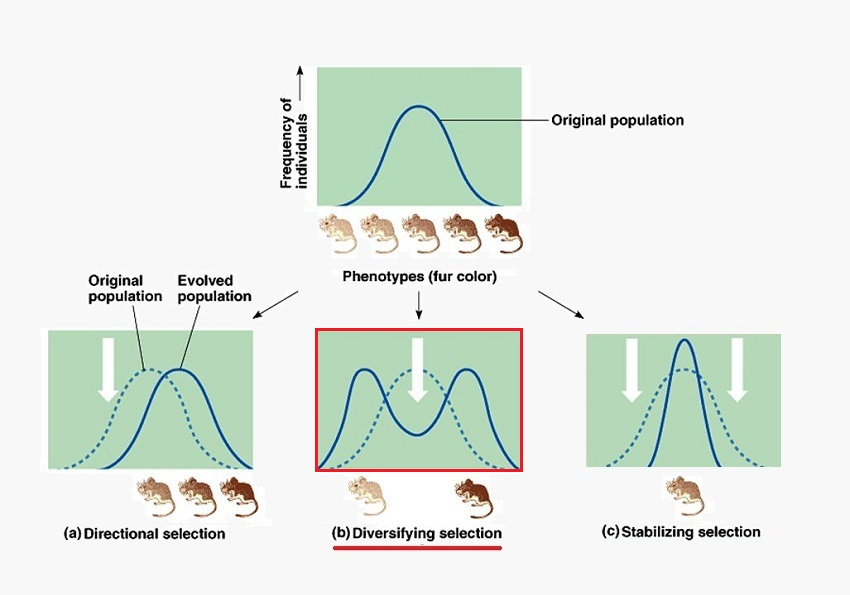
(Patterns of Natural Selection) What EFFECT on TRAIT DISTRIBUTION does DIRECTIONAL SELECTION have?
The mean (average) phenotype shifts left or right
Variation may stay similar or decrease slightly
Alleles for the favored phenotype increase in frequency
(Patterns of Natural Selection) Directional Selection: Real-World Example - Peppered Moths
Before the Industrial Revolution, light-colored moths camouflaged better → higher survival.
Coal pollution darkened trees; dark moths became better camouflaged.
Directional shift from light → dark morphs.
Change in allele frequencies: the allele for dark coloration increased.
(Patterns of Natural Selection) Directional Selection: Micro vs. Macroevolution
This is a classic example of microevolution.
Over long periods, directional selection can produce new species if populations diverge enough → potential macroevolution.
(Patterns of Natural Selection) What is STABILIZING SELECTION?
Stabilizing selection favors intermediate (average) phenotypes over the extremes. This maintains the existing mean and reduces variation.

(Patterns of Natural Selection) What EFFECT on TRAIT DISTRIBUTION does STABILIZING SELECTION have?
Mean stays the same
Curve becomes narrower and taller
Genetic variation decreases
(Patterns of Natural Selection) Stabilizing Selection: Real-World Example - Human Birth Weight
Very low birth weight → higher mortality
Very high birth weight → difficult labor, higher risks
Intermediate birth weights → highest survival
→ Stabilizing selection keeps birth weights near an optimal range.
(Patterns of Natural Selection) Stabilizing Selection: Micro vs. Macroevolution
Primarily prevents large changes → microevolutionary constraint
Reduces genetic diversity, which can affect long-term evolutionary potential but does not typically drive speciation.
(Patterns of Natural Selection) What is DISRUPTIVE (DIVERSIFYING) SELECTION?
Disruptive selection favors both extreme phenotypes, while selecting against intermediate forms.
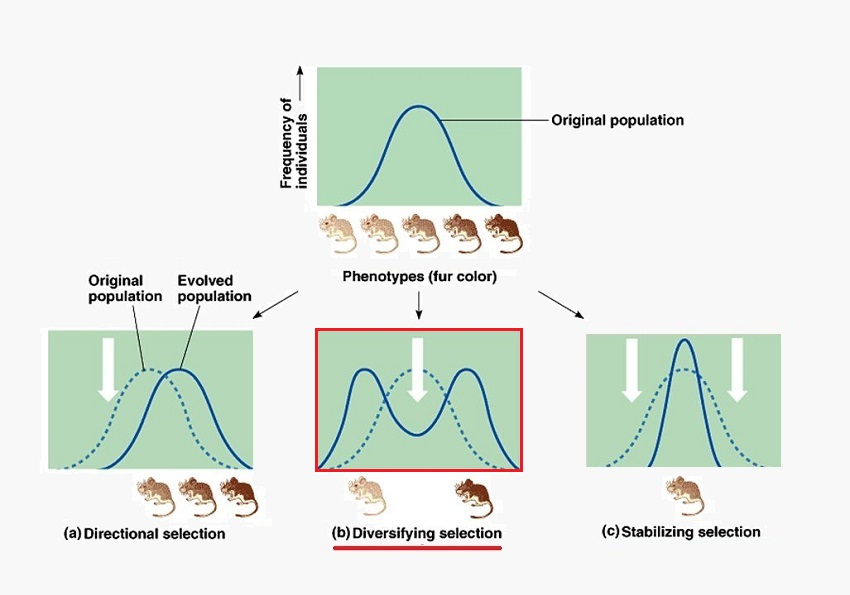
(Patterns of Natural Selection) What EFFECT on TRAIT DISTRIBUTION does DISRUPTIVE (DIVERSIFYING) SELECTION have?
The mean becomes less common
Variation increases
The population may split into two phenotypic groups
(Patterns of Natural Selection) Disruptive (Diversifying) Selection: Real-World Example - African Seedcracker Finches
Birds with very large beaks can crack hard seeds.
Birds with very small beaks can handle soft seeds efficiently.
Medium beaks are inefficient at both, so they survive less.
Result → two distinct beak sizes within the same species.
(Patterns of Natural Selection) Disruptive (Diversifying) Selection: Micro vs. Macroevolution
Increases variation and can form distinct subpopulations.
Can lead to speciation if groups stop interbreeding → a path to macroevolution.
(Patterns of Natural Selection) How do patterns of natural selection change GENE FREQUENCIES?: Directional
Increases frequency of alleles for one extreme phenotype.
Rapid microevolution.
(Patterns of Natural Selection) How do patterns of natural selection change GENE FREQUENCIES?: Stabilizing
Removes extreme alleles.
Decreases variation.
Maintains current mean phenotype.
(Patterns of Natural Selection) How do patterns of natural selection change GENE FREQUENCIES?: Disruptive
Increases allele frequencies at both extremes.
Often increases genetic variation the most.
Can lead to reproductive isolation → macroevolution.